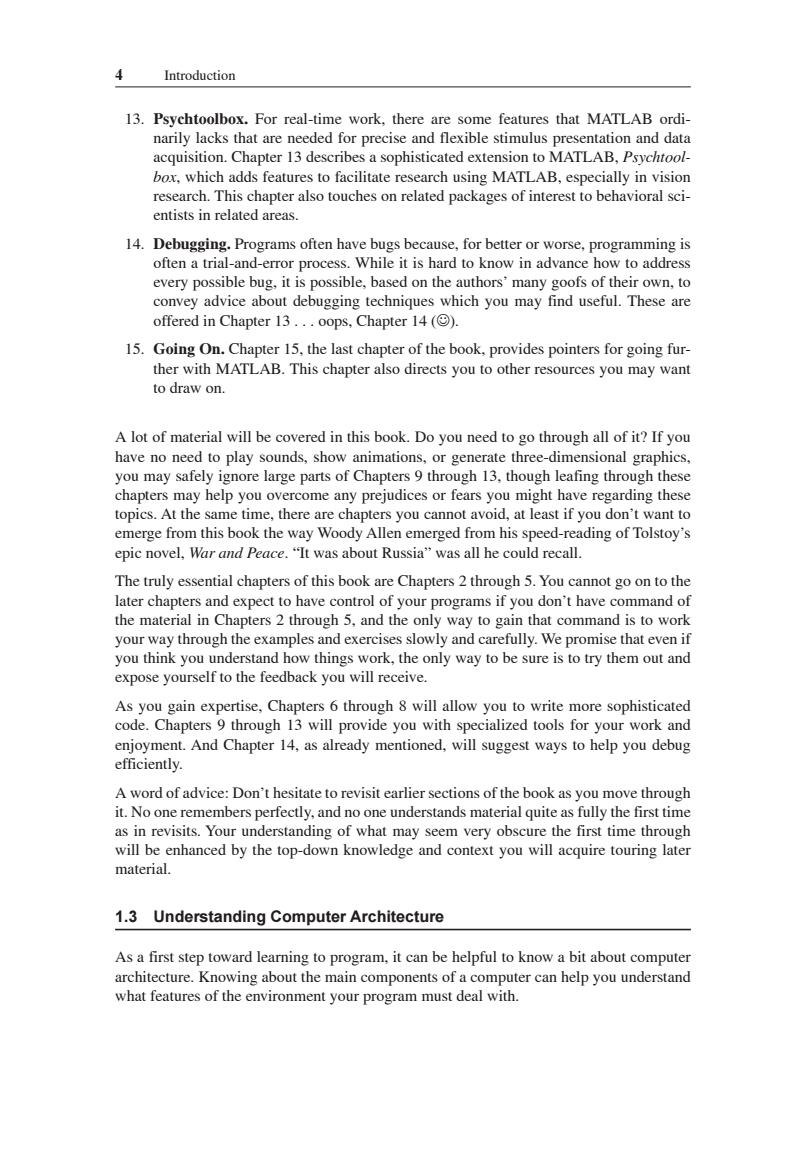正在加载图片...

4 Introduction 13.Psychtoolbox.For real-time work,there are some features that MATLAB ordi- narily lacks that are needed for precise and flexible stimulus presentation and data acquisition.Chapter 13 describes a sophisticated extension to MATLAB,Psychtool box.which adds features to facilitate research using MATLAB.especially in vision research.This chapter also touches on related packages of interest to behavioral sci entists in related areas. 14.Debugging.Programs often have bugs because,for better or worse,programming is often a tria and-error procetowto addre every poss r own,to These are ther h MATLAB.T ovides pointers for going fur draw on A lot of material will be cov vered in this book. rough all of it?If have no ne ed to play sound or gen S0 al graphic you may safe rge parts o ugh 1 fing thr 11 y ast if dy Alle ed fr m his s eed-reading of Tols epic novel,War and Peace."I was about Russia" The truly essential chapters of this book are Chapters 2 through 5.You cannot go on to the later chanters and exneet to have control of your ograms if you don't have command of the material in cha ers2 through 5.and the only way to gain that command is to work your way through the examples and exercises slowly and carefully.We promise that even if you think you understand how things work,the only way to be sure is to try them out and expose yourself to the feedback you will receive. As you gain expertise,Chapters 6 through 8 will allow you to write more sophisticated code.Chapters 9 through 13 will provide you with specialized tools for your work and enjoyment.And Chapter 14,as already mentioned,will suggest ways to help you debug efficiently. A word of advice:Don't hesitate to revisit earlier sections of the book as you move through it.No one remembers perfectly,and no one understands material quite as fully the first time as in revi ling of what may seem very obscure the R r un derstand t time throug 1.3 Understanding Computer Architecture 4 Introduction 13. Psychtoolbox. For real-time work, there are some features that MATLAB ordinarily lacks that are needed for precise and flexible stimulus presentation and data acquisition. Chapter 13 describes a sophisticated extension to MATLAB, Psychtoolbox , which adds features to facilitate research using MATLAB, especially in vision research. This chapter also touches on related packages of interest to behavioral scientists in related areas. 14. Debugging. Programs often have bugs because, for better or worse, programming is often a trial-and-error process. While it is hard to know in advance how to address every possible bug, it is possible, based on the authorsÊ many goofs of their own, to convey advice about debugging techniques which you may find useful. These are offered in Chapter 13 . . . oops, Chapter 14 (). 15. Going On. Chapter 15, the last chapter of the book, provides pointers for going further with MATLAB. This chapter also directs you to other resources you may want to draw on. A lot of material will be covered in this book. Do you need to go through all of it? If you have no need to play sounds, show animations, or generate three-dimensional graphics, you may safely ignore large parts of Chapters 9 through 13, though leafing through these chapters may help you overcome any prejudices or fears you might have regarding these topics. At the same time, there are chapters you cannot avoid, at least if you donÊt want to emerge from this book the way Woody Allen emerged from his speed-reading of TolstoyÊs epic novel, War and Peace . „It was about Russia‰ was all he could recall. The truly essential chapters of this book are Chapters 2 through 5. You cannot go on to the later chapters and expect to have control of your programs if you donÊt have command of the material in Chapters 2 through 5, and the only way to gain that command is to work your way through the examples and exercises slowly and carefully. We promise that even if you think you understand how things work, the only way to be sure is to try them out and expose yourself to the feedback you will receive. As you gain expertise, Chapters 6 through 8 will allow you to write more sophisticated code. Chapters 9 through 13 will provide you with specialized tools for your work and enjoyment. And Chapter 14, as already mentioned, will suggest ways to help you debug efficiently. A word of advice: DonÊt hesitate to revisit earlier sections of the book as you move through it. No one remembers perfectly, and no one understands material quite as fully the first time as in revisits. Your understanding of what may seem very obscure the first time through will be enhanced by the top-down knowledge and context you will acquire touring later material. 1.3 Understanding Computer Architecture As a first step toward learning to program, it can be helpful to know a bit about computer architecture. Knowing about the main components of a computer can help you understand what features of the environment your program must deal with